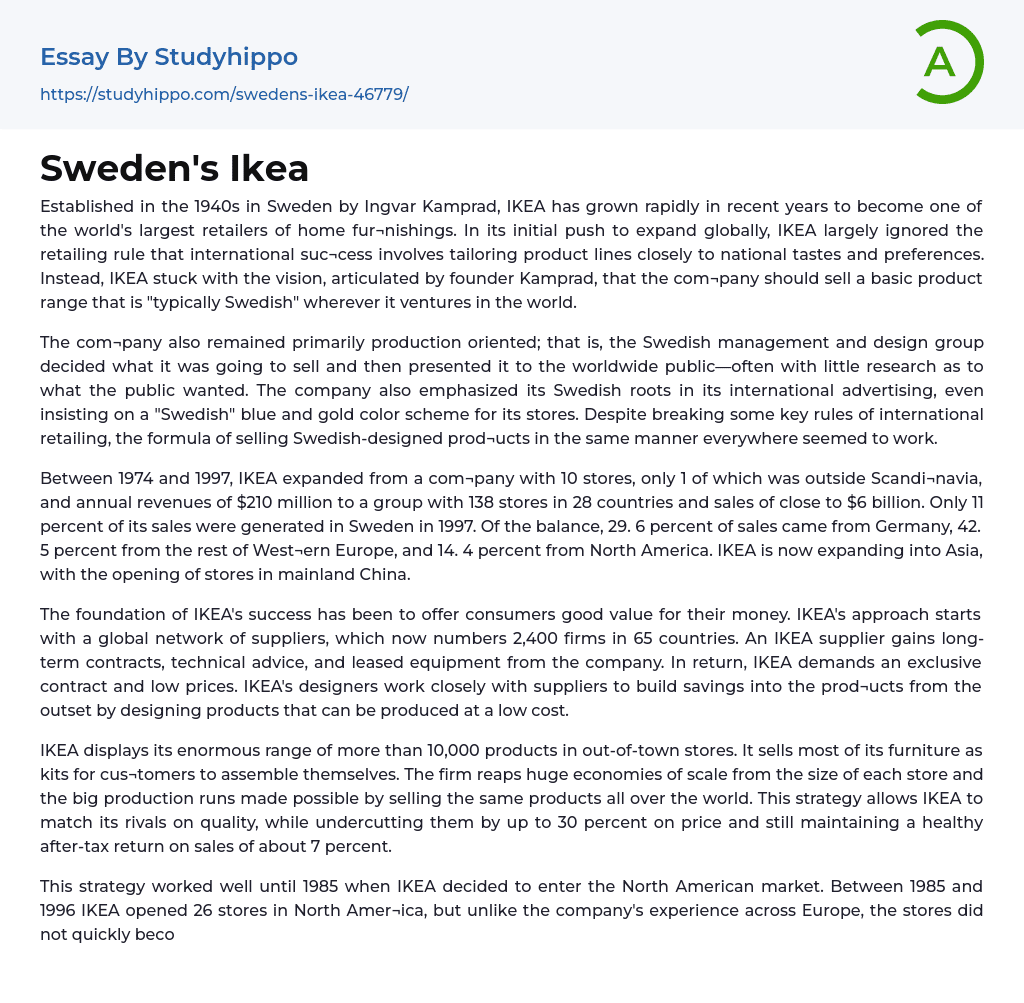Since its establishment in the 1940s in Sweden, IKEA has grown rapidly and is now one of the largest home furnishings retailers globally. Unlike other retailers who adapt their products to meet specific national preferences, IKEA remains committed to honoring founder Ingvar Kamprad's vision. This vision involves offering a core product range that embodies the distinctive Swedish identity across all their international endeavors.
The company's approach was primarily production-oriented. The Swedish management and design group determined what products to sell and presented them to the global audience without much market research. They also promoted their Swedish origins through international advertising, using a blue and gold color scheme in their stores. Despite deviating from international retailing norms, the strategy of selling Swedish-designed products uniformly appeared to be successful.
Between 1974 and 1997, I
...KEA experienced significant growth, expanding from just 10 stores (only one of which was located outside Scandinavia) and generating $210 million in annual revenue. During this period, IKEA expanded its presence to encompass 138 stores in 28 countries, achieving sales nearing $6 billion. By 1997, Sweden accounted for a small fraction (11 percent) of its overall sales. The majority of its revenue stemmed from Germany (29.6 percent), the rest of Western Europe (42.5 percent), and North America (14.4 percent). Additionally, IKEA recently made strides into the Asian market with the establishment of new stores in mainland China.
IKEA's success is attributed to its ability to offer consumers affordable and cost-effective products. This is achieved through a global network of 2,400 suppliers from 65 countries. IKEA establishes long-term contracts with suppliers, providing technical support and leased equipment as incentives for exclusive agreements and competitiv
pricing. The collaboration between IKEA's designers and suppliers is crucial in creating cost-efficient products.
IKEA displays more than 10,000 items in its suburban stores, with a majority of its furniture available as DIY kits. This grants customers various benefits. The company's large store spaces and capability to sell products worldwide facilitate efficient production runs, which in turn enables IKEA to offer prices that are up to 30 percent lower than competitors while still achieving a satisfactory after-tax return on sales of around 7 percent.
The strategy was successful until 1985 when IKEA decided to enter the North American market. Within the period of 1985 to 1996, IKEA established 26 stores in North America. However, unlike the company's success in Europe, these stores did not immediately generate profit. As early as 1990, the challenges with IKEA's operations in North America became evident. A significant factor was the negative impact of exchange rates. In 1985, $1 was equivalent to 8.6 Swedish kronor; by 1990, it had decreased to $1 being equal to Skr5.8.
At the current exchange rate, Swedish products imported by IKEA did not appear inexpensive to American consumers. However, IKEA faced more issues than just unfavorable exchange rates. The distinctly Swedish nature of IKEA's products, which had been successful in Europe, did not align with American preferences and sometimes didn't fit their physique. The beds from Sweden were narrow and measured in centimeters. American consumers preferred matching bedroom suites, which IKEA did not offer. Additionally, the kitchen cupboards were too narrow for large dinner plates and the glasses were too small for a nation that frequently uses ice.
The bedroom chests sold by IKEA had
drawers that were insufficiently deep for American consumers, who commonly use them to store sweaters. Furthermore, the company erred in selling curtains specifically designed for European windows which did not fit American windows. A senior manager at IKEA later made a jest about Americans being unwilling to adjust their ceilings for the curtains. However, in 1991, the top management of IKEA acknowledged the necessity of modifying their product line to cater to North American preferences if they wished to thrive in this market. Consequently, the company commenced redesigning its range of products.
The sales of bedroom chests experienced an immediate increase of 30 to 40 percent with the implementation of two inches deeper drawers. To meet the preferences of American customers, IKEA now provides American-style king and queen-sized beds, which are measured in inches, as part of complete bedroom suites. Furthermore, IKEA has revamped its kitchen furniture and kitchenware to better suit the tastes of Americans. Moreover, the company has elevated the proportion of locally sourced products from 15 percent in 1990 to 45 percent in 1997. This strategic decision helps protect the company from fluctuations in exchange rates.
- Advertising essays
- Audience Theory essays
- Competitor Analysis essays
- Consumer essays
- Marketing Management essays
- Marketing Mix essays
- Marketing Plan essays
- Marketing Research essays
- Marketing Strategy essays
- Point Of Sale essays
- Price essays
- Procurement essays
- Product essays
- Product Differentiation essays
- Promotion essays
- Promotion And Marketing Communications essays
- Retailing essays
- Trademark essays
- Anheuser-busch essays
- Brands essays
- Detergent essays
- Product Placement essays
- Research Design essays
- New Product Development essays
- Advertisement essays
- Brand essays
- Sales Promotion essays
- Advertising campaign essays
- Consumer behaviour essays
- Offer And Acceptance essays
- Wal-Mart essays
- Discover essays
- Adidas essays
- Amazon essays
- Apple essays
- Bmw essays
- British Airways essays
- Burger King essays
- Coca-Cola essays
- Company essays
- Costco essays
- Dell essays
- Ebay essays
- Enron essays
- Facebook essays
- Ford Motor Company essays
- Gap essays
- General Motors essays
- Google essays
- Honda essays




